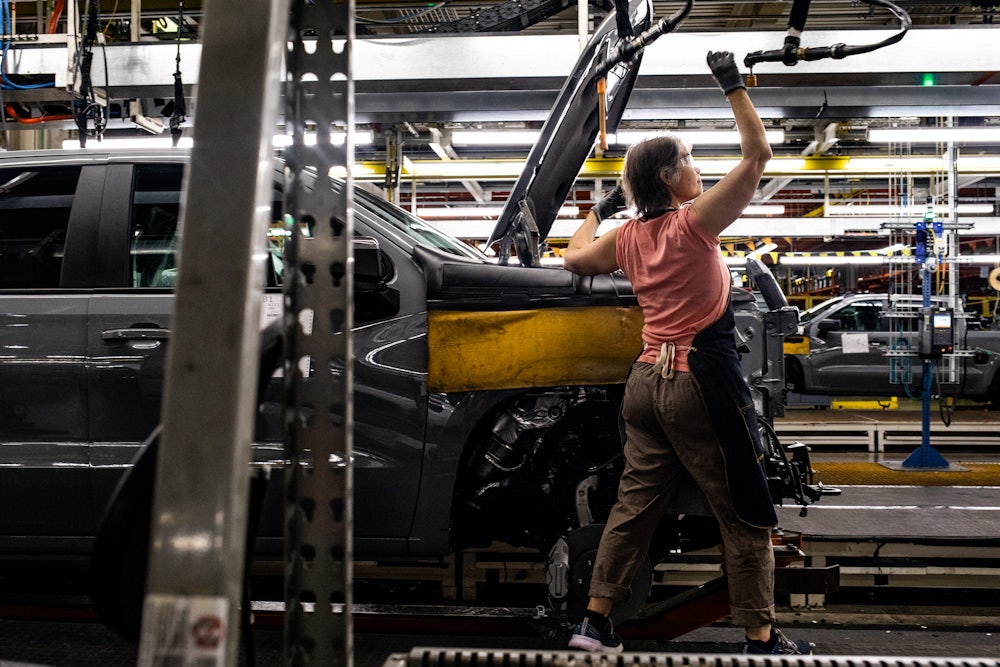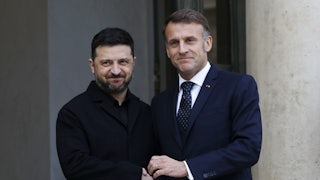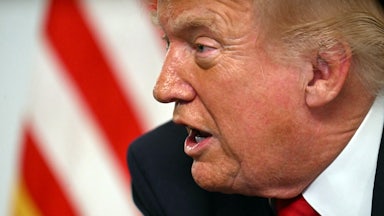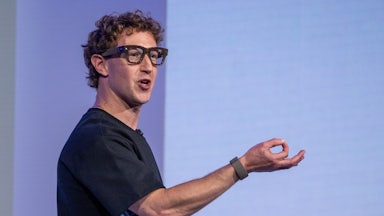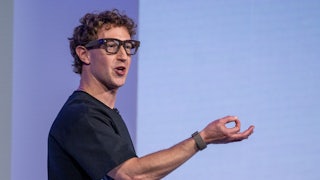When the journalist Josh Barro interviewed Representative Ritchie Torres of New York earlier this month at WelcomeFest, a gathering of abundance agenda enthusiasts hosted by the center-left Welcome PAC in D.C., Barro made a comment that seemed—to his critics—to say the quiet part out loud. “When I look at policies in New York that stand in the way of abundance, very often if you look under the hood, you eventually find a labor union at the end that’s the driver,” he said.
“The Abundance Mask Slips at WelcomeFest,” announced a post at the Revolving Door Project, where Henry Burke and Vishal Shankar called Barro’s remark an “accidental Abundance confession” and said it revealed that abundance “was neoliberalism all along.” “This strategy has little to do with ‘broadening the Democratic tent,’ despite what some might have you believe,” they wrote, “and everything to do with moving the tentpoles to exclude non-elites.” Many others took note of the exchange, seeing it as revealing the real intentions of the Abundists (as their critics call them).
Abundance, the March book by The New York Times’ Ezra Klein and The Atlantic’s Derek Thompson that has ignited an intraparty debate, does not actually go into depth about labor unions. It argues that Democrats need to work to build housing, green energy projects, high-speed rail, and other infrastructure faster and better—and acknowledges that doing so may require sidelining various interest groups in the progressive coalition. Though the book only mentions unions a couple of times, critics have suggested that it could provide ammunition for centrists who want to disempower the labor movement (which, though some of its rank and file have shifted toward Trumpism, is still very much a Democratic power player). To these critics, Barro’s comment was confirmation of what they’d suspected—and it was telling when Torres, who represents parts of the Bronx and has supported abundance, demurred in his conversation with Barro and later said on a podcast that abundance wasn’t anti-union.
Barro’s swing at unions hints at a bigger issue with abundance and those who support it. Unions aren’t merely a Democratic interest group; they’re a mechanism, one of few that exist, for giving workers a seat at the table with big business, ensuring that the benefits from projects are shared by those who work on them and the communities they come from. By design, union leadership includes the working-class laborers they represent, and is one of the few ways blue- and pink-collar members can push their values on the elites who run conversations in D.C.
At the same time, Barro and his ilk overstate the power of unions, which still have influence in blue cities but have shrunk from their midcentury heights. The examples he marshaled to make his case in a blog post published after WelcomeFest were small bore, all focusing on New York City.
One was that the city’s Transit Workers Union chapter, whose members operate the buses, subways, and stations of the Metropolitan Transit Authority, have insisted on two employees for each subway train—a driver and a conductor. The union says that conductors, who close and open the doors, are necessary for safety, but it’s true that New York City is one of the few big subway systems in the world that still assigns two workers per train. Even if the MTA should eliminate conductors, though, it would save an incredibly small amount of money. As of May, the MTA employed 3,364 conductors out of a total of 70,000 employees for the entire MTA system. Labor costs are a little over half the MTA’s nearly $20 billion budget. Which is to say, getting rid of the conductors would not save much money in the scheme of things.
It could very well be that the city’s trains will run just fine with only one worker, and perhaps the MTA should push for that in its next contract with the union. But why is a proponent of “abundance” quibbling over a few million dollars that comprise such a tiny portion of a public budget, one that pays working-class New Yorkers for one of the few jobs available to those who haven’t gone to college? That doesn’t sound like abundance. It sounds like scarcity, the mindset the Abundance authors were pushing back against.
The three other anti-union examples Barro cited are more complicated than he presents. In one, he cites the wage and affordability thresholds housing developers have to meet to qualify for tax incentives if they don’t use union labor. Barro says this requirement “makes the program less financially attractive and therefore it is less effective at producing new housing.” But this is how tax credits work: Governments want something in exchange for forgoing tax revenue, and in demanding affordable units the city is representing what residents want. Barro was echoing a core argument of Abundance: that more housing supply will lower the cost of all housing and solve most problems of affordability. But this requires an absolute faith in the free market and ignores the role rising institutional investment in housing may be playing, and the fact that the market is unlikely to provide housing for low- and very low-income families, which it never has.
Barro also argued that the city’s powerful hotel workers’ union had caused room rates to increase by insisting on a special permitting process for building new hotels, and attacked teachers’ unions for lobbying for extended Covid closures in public schools and for reduced class sizes. With hotels, increases in prices have as much to do with their use as shelters after travel fell during the pandemic; and a return to in-person learning after the pandemic was about more than unions. In all of Barro’s bullet points, the issues at hand are more nuanced than he suggests, and blaming them solely on unions, who do in fact represent the interests of their middle-class members, ignores the other forces at play.
Unions might make decisions on the margins that, as Barro argues, don’t serve the broadest public interest. In blue cities, it may be that Democrats are trying to keep too many groups happy and to accomplish too many goals with every tiny project, as the Abundance authors argue. That may be especially true in San Francisco, where Nimbyism has clashed with otherwise progressive goals like affordable housing. Indeed, Klein and Thompson’s book has struck a chord with many California Democrats.
“The abundance agenda speaks to a desire in America that we do big things again, that we build things, and it is an important intellectual contribution to the party,” said Representative Ro Khanna, a progressive Democrat whose California district covers part of Silicon Valley, one of the richest areas in the country, suffering from acute housing shortages and affordability issues. He told me he thought abundance could be one of the many tools Democrats could use in campaigning and governing. “I think the country wants new dreams, wants new excitement. They’re looking for the Kennedy-esque spirit that inspired my parents to come to the United States.”
As proponents of abundance see it, progressives have been too concerned with equity and not concerned enough with simply fulfilling their promises and building the kind of country it wants to see. Khanna invoked FDR, who, with the Works Progress Administration, built an agency that sidestepped federal rules, permitting, and red tape in order to accomplish the singular goal of putting the unemployed back to work as quickly as possible. Nothing was radically different about the American system of government then: FDR just used his power differently.
But portraying progressives’ concerns as simply a matter for interest groups ignores the positive impact of those groups and risks steamrolling their concerns, and that’s perhaps especially true when it comes to unions. In a piece for the Roosevelt Institute, Kate Andrias and Alexander Hertel-Fernandez, two scholars at Columbia University’s Labor Lab, outline how unions could help an abundance agenda: They have the construction expertise that big projects require, can organize their members to support projects and complete them quickly, and can be voices for the working class throughout the process to make sure the community shares equally in whatever abundance results. As TNR’s Tim Noah wrote in March:
Klein and Thompson point out that it costs twice as much to build a kilometer of rail in the United States as it does in Japan or Canada, and that union density is much higher in the latter two countries. Consequently, they argue, unions can’t logically be the problem.… Still, not talking much about unions isn’t good enough. The authors of these books ought to consider unions part of the solution to housing affordability. Boost wages, and people can buy houses.
In the U.S., union density was at its highest in the 1950s, a time when the nation was transformed from coast to coast by ambitious, landscape-altering infrastructure projects like the Interstate Highway System. It was also an era in which the government aggressively built and maintained housing for lower-income and working-class families and found new ways to invest in education and health. Union density has declined since the Reagan revolution, when business interests aligned with Republicans to chip away at labor’s political and economic power. Since then, wages in the country have grown more unequal and the political will for big, government-funded projects has diminished.
Highways also are a cautionary tale. In building the Interstate system, the U.S. made the country dependent on cars, reducing the availability of public transit in most places and springboarding us into our climate-disaster future. Local projects, like many of the highways built in New York City, decimated vibrant, middle-class neighborhoods and contributed to the decline in population—and thus in property tax revenue—that weakened public services like the subway. History is littered with the kinds of projects people thought were forward-thinking and good but that caused intractable social problems later. These examples are why we have the review processes and community hearings for capital improvements today.
In their heyday, unions brought the working class on board with decisions by people in power, while also negotiating tradeoffs to ensure that their communities would benefit more than they suffered. They helped to create one of the most robust middle classes in the history of the world (with the critical caveat that women, Black Americans, and marginalized groups were often excluded). But as unions have declined, and Republicans have waged war on government policies that spur economic mobility, much of the world’s wealth creation of the past few decades has been concentrated at the very top. There’s certainly an abundance of it, as TNR’s latest issue makes clear; the challenge facing Democrats is how to redistribute it to build the things—yes, more housing, better trains, clean energy—that we can all agree would make the country a much better, and fairer, country.
